Analyzing Dynamic Capabilities, RBV, and Business Strategy
VerifiedAdded on 2023/01/18
|9
|2334
|97
Essay
AI Summary
This essay provides a comprehensive analysis of dynamic capabilities and their significance in achieving and sustaining competitive advantage within a dynamic business environment. It begins by highlighting the importance of creating and maintaining a competitive edge, emphasizing the role of intangible assets and marketing capabilities. The essay then delves into the Resource-Based View (RBV), explaining its strategic approach to leverage internal resources for success, while also discussing the limitations of RBV. The core of the essay focuses on dynamic capabilities, defining them as the ability to integrate and build internal and external competencies to address changing business environments, differentiating them from operational capabilities. It outlines the four key procedures of dynamic capabilities: sensing, seizing, reconfiguring, and transforming, and applies these concepts to the financial services industry. The essay offers a valuable perspective for students seeking to understand the strategic management and business development.
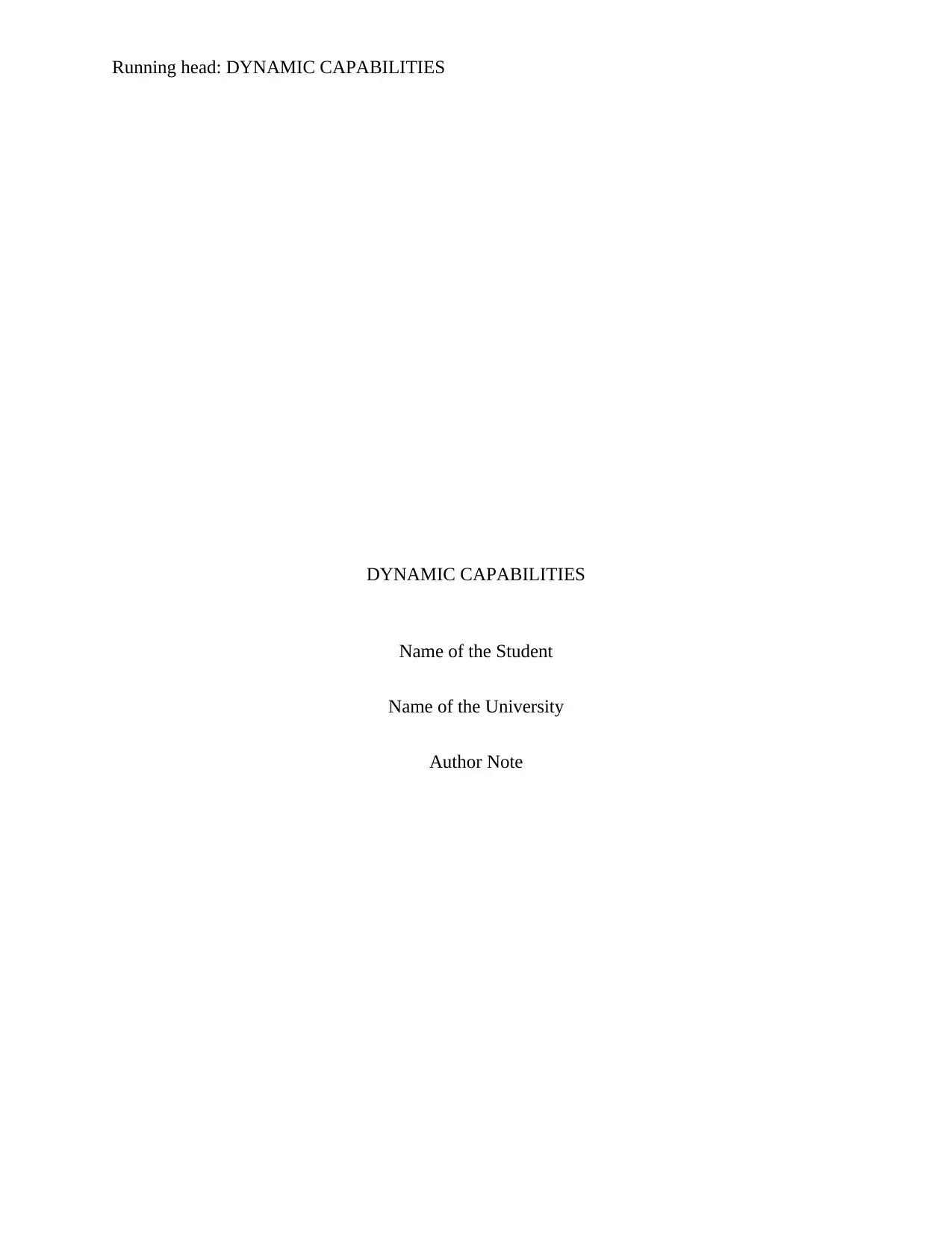
Running head: DYNAMIC CAPABILITIES
DYNAMIC CAPABILITIES
Name of the Student
Name of the University
Author Note
DYNAMIC CAPABILITIES
Name of the Student
Name of the University
Author Note
Paraphrase This Document
Need a fresh take? Get an instant paraphrase of this document with our AI Paraphraser
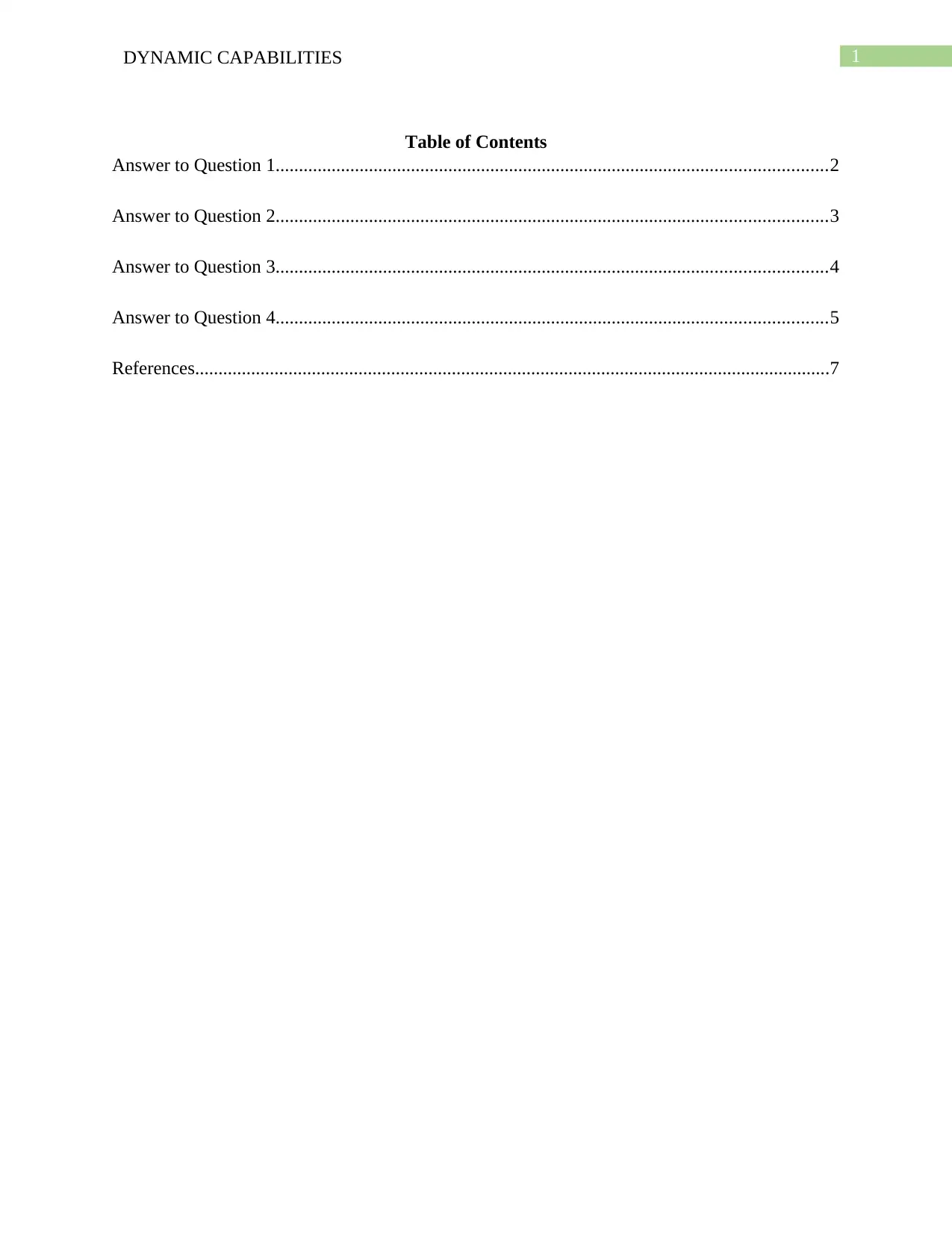
1DYNAMIC CAPABILITIES
Table of Contents
Answer to Question 1......................................................................................................................2
Answer to Question 2......................................................................................................................3
Answer to Question 3......................................................................................................................4
Answer to Question 4......................................................................................................................5
References........................................................................................................................................7
Table of Contents
Answer to Question 1......................................................................................................................2
Answer to Question 2......................................................................................................................3
Answer to Question 3......................................................................................................................4
Answer to Question 4......................................................................................................................5
References........................................................................................................................................7
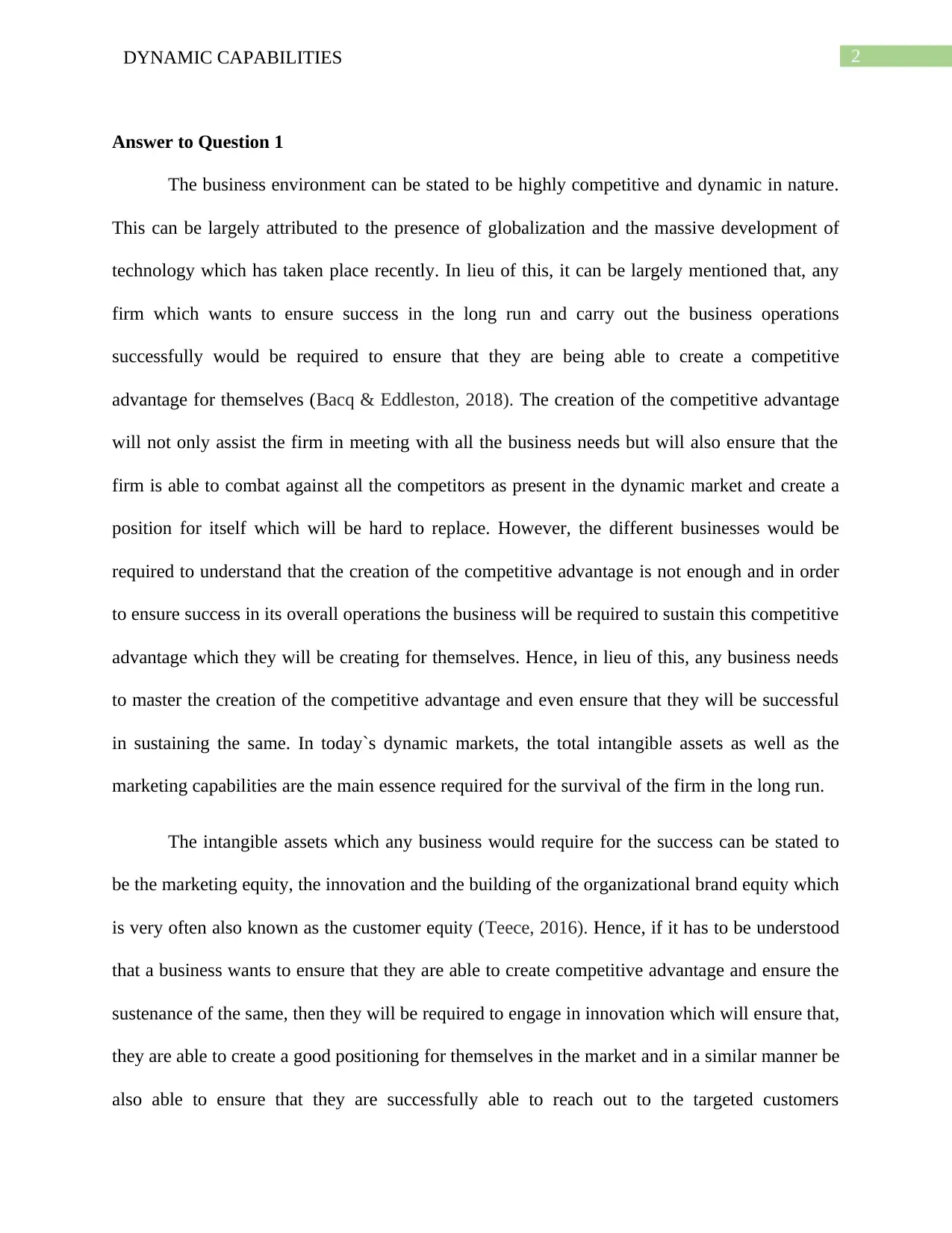
2DYNAMIC CAPABILITIES
Answer to Question 1
The business environment can be stated to be highly competitive and dynamic in nature.
This can be largely attributed to the presence of globalization and the massive development of
technology which has taken place recently. In lieu of this, it can be largely mentioned that, any
firm which wants to ensure success in the long run and carry out the business operations
successfully would be required to ensure that they are being able to create a competitive
advantage for themselves (Bacq & Eddleston, 2018). The creation of the competitive advantage
will not only assist the firm in meeting with all the business needs but will also ensure that the
firm is able to combat against all the competitors as present in the dynamic market and create a
position for itself which will be hard to replace. However, the different businesses would be
required to understand that the creation of the competitive advantage is not enough and in order
to ensure success in its overall operations the business will be required to sustain this competitive
advantage which they will be creating for themselves. Hence, in lieu of this, any business needs
to master the creation of the competitive advantage and even ensure that they will be successful
in sustaining the same. In today`s dynamic markets, the total intangible assets as well as the
marketing capabilities are the main essence required for the survival of the firm in the long run.
The intangible assets which any business would require for the success can be stated to
be the marketing equity, the innovation and the building of the organizational brand equity which
is very often also known as the customer equity (Teece, 2016). Hence, if it has to be understood
that a business wants to ensure that they are able to create competitive advantage and ensure the
sustenance of the same, then they will be required to engage in innovation which will ensure that,
they are able to create a good positioning for themselves in the market and in a similar manner be
also able to ensure that they are successfully able to reach out to the targeted customers
Answer to Question 1
The business environment can be stated to be highly competitive and dynamic in nature.
This can be largely attributed to the presence of globalization and the massive development of
technology which has taken place recently. In lieu of this, it can be largely mentioned that, any
firm which wants to ensure success in the long run and carry out the business operations
successfully would be required to ensure that they are being able to create a competitive
advantage for themselves (Bacq & Eddleston, 2018). The creation of the competitive advantage
will not only assist the firm in meeting with all the business needs but will also ensure that the
firm is able to combat against all the competitors as present in the dynamic market and create a
position for itself which will be hard to replace. However, the different businesses would be
required to understand that the creation of the competitive advantage is not enough and in order
to ensure success in its overall operations the business will be required to sustain this competitive
advantage which they will be creating for themselves. Hence, in lieu of this, any business needs
to master the creation of the competitive advantage and even ensure that they will be successful
in sustaining the same. In today`s dynamic markets, the total intangible assets as well as the
marketing capabilities are the main essence required for the survival of the firm in the long run.
The intangible assets which any business would require for the success can be stated to
be the marketing equity, the innovation and the building of the organizational brand equity which
is very often also known as the customer equity (Teece, 2016). Hence, if it has to be understood
that a business wants to ensure that they are able to create competitive advantage and ensure the
sustenance of the same, then they will be required to engage in innovation which will ensure that,
they are able to create a good positioning for themselves in the market and in a similar manner be
also able to ensure that they are successfully able to reach out to the targeted customers
⊘ This is a preview!⊘
Do you want full access?
Subscribe today to unlock all pages.

Trusted by 1+ million students worldwide
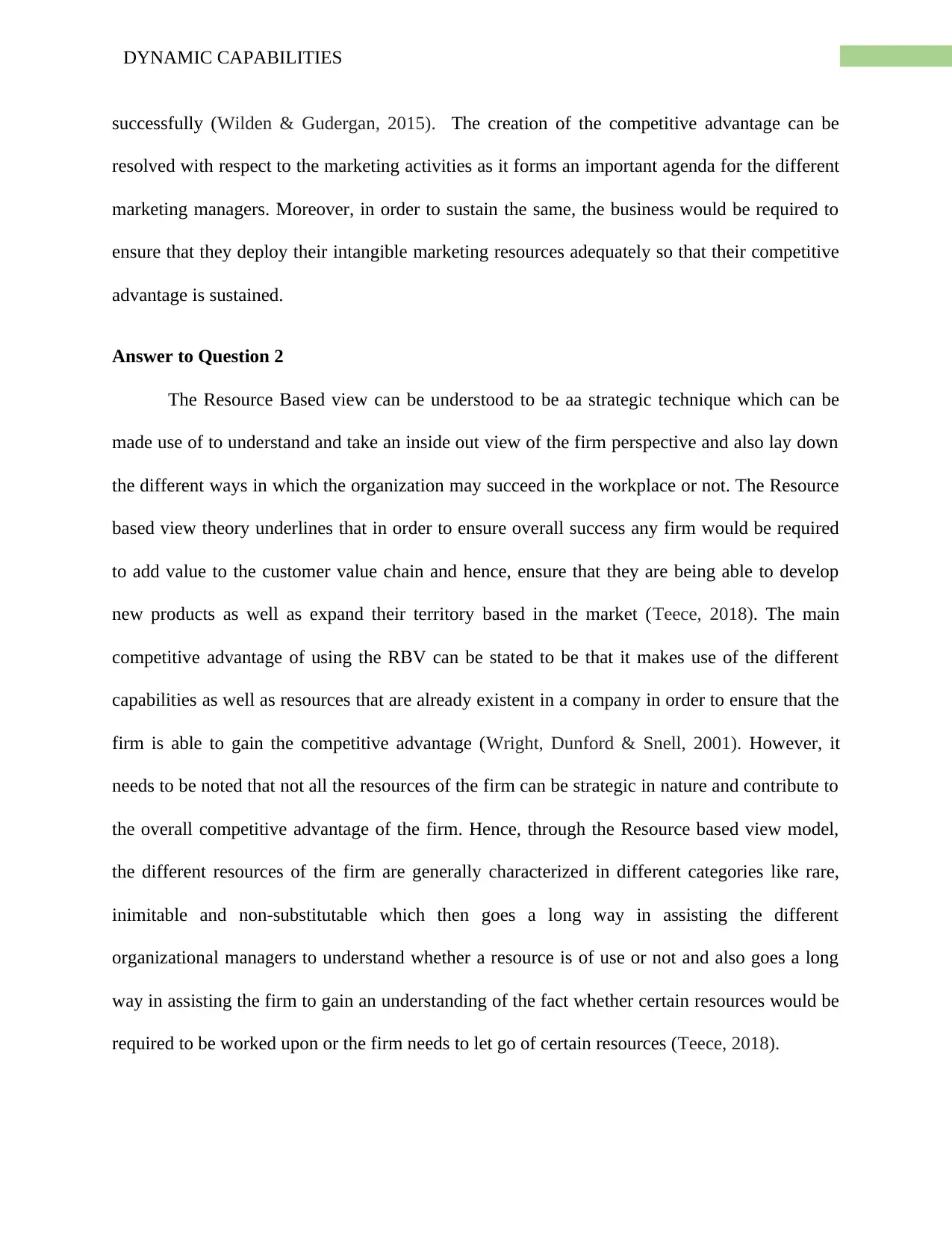
3DYNAMIC CAPABILITIES
successfully (Wilden & Gudergan, 2015). The creation of the competitive advantage can be
resolved with respect to the marketing activities as it forms an important agenda for the different
marketing managers. Moreover, in order to sustain the same, the business would be required to
ensure that they deploy their intangible marketing resources adequately so that their competitive
advantage is sustained.
Answer to Question 2
The Resource Based view can be understood to be aa strategic technique which can be
made use of to understand and take an inside out view of the firm perspective and also lay down
the different ways in which the organization may succeed in the workplace or not. The Resource
based view theory underlines that in order to ensure overall success any firm would be required
to add value to the customer value chain and hence, ensure that they are being able to develop
new products as well as expand their territory based in the market (Teece, 2018). The main
competitive advantage of using the RBV can be stated to be that it makes use of the different
capabilities as well as resources that are already existent in a company in order to ensure that the
firm is able to gain the competitive advantage (Wright, Dunford & Snell, 2001). However, it
needs to be noted that not all the resources of the firm can be strategic in nature and contribute to
the overall competitive advantage of the firm. Hence, through the Resource based view model,
the different resources of the firm are generally characterized in different categories like rare,
inimitable and non-substitutable which then goes a long way in assisting the different
organizational managers to understand whether a resource is of use or not and also goes a long
way in assisting the firm to gain an understanding of the fact whether certain resources would be
required to be worked upon or the firm needs to let go of certain resources (Teece, 2018).
successfully (Wilden & Gudergan, 2015). The creation of the competitive advantage can be
resolved with respect to the marketing activities as it forms an important agenda for the different
marketing managers. Moreover, in order to sustain the same, the business would be required to
ensure that they deploy their intangible marketing resources adequately so that their competitive
advantage is sustained.
Answer to Question 2
The Resource Based view can be understood to be aa strategic technique which can be
made use of to understand and take an inside out view of the firm perspective and also lay down
the different ways in which the organization may succeed in the workplace or not. The Resource
based view theory underlines that in order to ensure overall success any firm would be required
to add value to the customer value chain and hence, ensure that they are being able to develop
new products as well as expand their territory based in the market (Teece, 2018). The main
competitive advantage of using the RBV can be stated to be that it makes use of the different
capabilities as well as resources that are already existent in a company in order to ensure that the
firm is able to gain the competitive advantage (Wright, Dunford & Snell, 2001). However, it
needs to be noted that not all the resources of the firm can be strategic in nature and contribute to
the overall competitive advantage of the firm. Hence, through the Resource based view model,
the different resources of the firm are generally characterized in different categories like rare,
inimitable and non-substitutable which then goes a long way in assisting the different
organizational managers to understand whether a resource is of use or not and also goes a long
way in assisting the firm to gain an understanding of the fact whether certain resources would be
required to be worked upon or the firm needs to let go of certain resources (Teece, 2018).
Paraphrase This Document
Need a fresh take? Get an instant paraphrase of this document with our AI Paraphraser
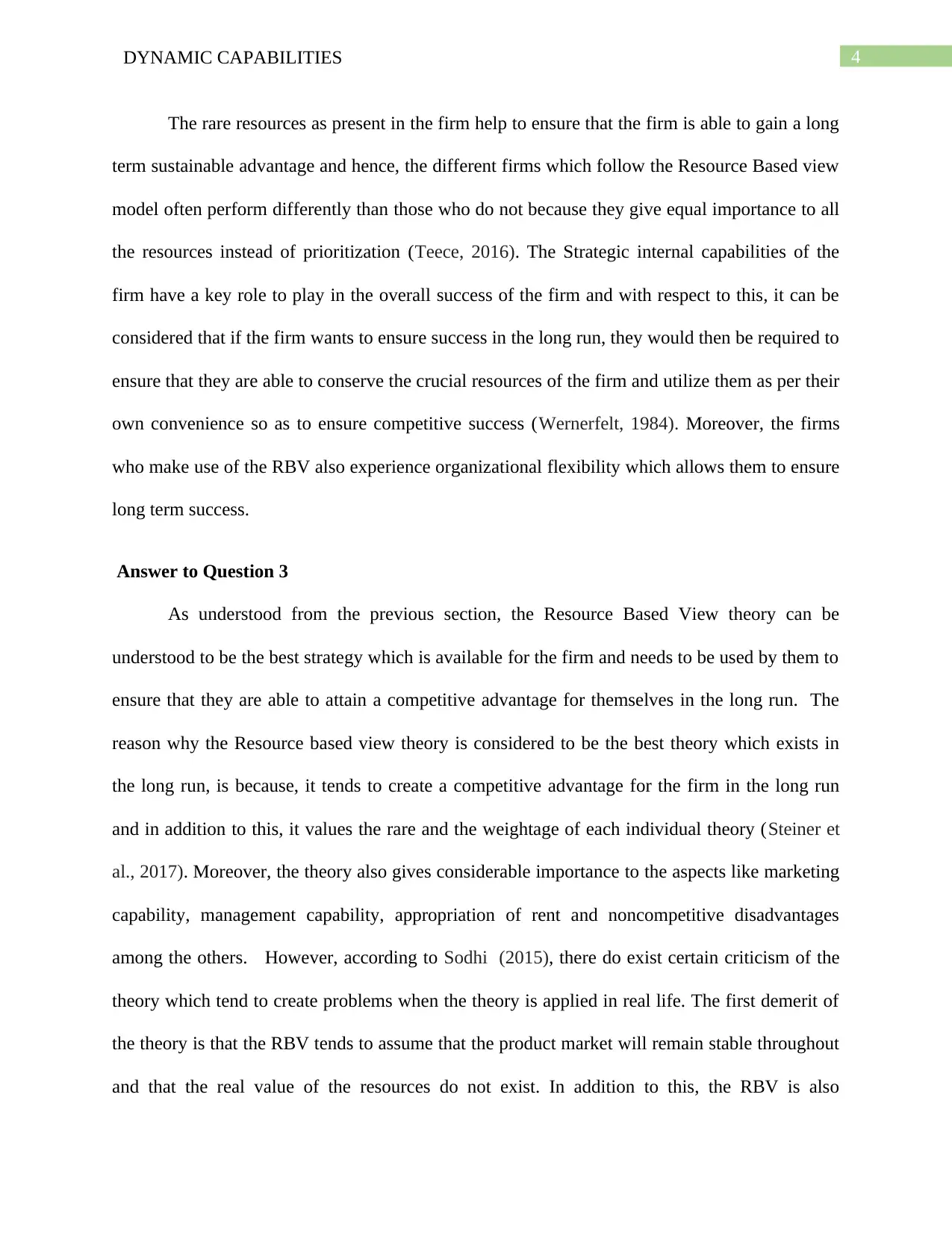
4DYNAMIC CAPABILITIES
The rare resources as present in the firm help to ensure that the firm is able to gain a long
term sustainable advantage and hence, the different firms which follow the Resource Based view
model often perform differently than those who do not because they give equal importance to all
the resources instead of prioritization (Teece, 2016). The Strategic internal capabilities of the
firm have a key role to play in the overall success of the firm and with respect to this, it can be
considered that if the firm wants to ensure success in the long run, they would then be required to
ensure that they are able to conserve the crucial resources of the firm and utilize them as per their
own convenience so as to ensure competitive success (Wernerfelt, 1984). Moreover, the firms
who make use of the RBV also experience organizational flexibility which allows them to ensure
long term success.
Answer to Question 3
As understood from the previous section, the Resource Based View theory can be
understood to be the best strategy which is available for the firm and needs to be used by them to
ensure that they are able to attain a competitive advantage for themselves in the long run. The
reason why the Resource based view theory is considered to be the best theory which exists in
the long run, is because, it tends to create a competitive advantage for the firm in the long run
and in addition to this, it values the rare and the weightage of each individual theory (Steiner et
al., 2017). Moreover, the theory also gives considerable importance to the aspects like marketing
capability, management capability, appropriation of rent and noncompetitive disadvantages
among the others. However, according to Sodhi (2015), there do exist certain criticism of the
theory which tend to create problems when the theory is applied in real life. The first demerit of
the theory is that the RBV tends to assume that the product market will remain stable throughout
and that the real value of the resources do not exist. In addition to this, the RBV is also
The rare resources as present in the firm help to ensure that the firm is able to gain a long
term sustainable advantage and hence, the different firms which follow the Resource Based view
model often perform differently than those who do not because they give equal importance to all
the resources instead of prioritization (Teece, 2016). The Strategic internal capabilities of the
firm have a key role to play in the overall success of the firm and with respect to this, it can be
considered that if the firm wants to ensure success in the long run, they would then be required to
ensure that they are able to conserve the crucial resources of the firm and utilize them as per their
own convenience so as to ensure competitive success (Wernerfelt, 1984). Moreover, the firms
who make use of the RBV also experience organizational flexibility which allows them to ensure
long term success.
Answer to Question 3
As understood from the previous section, the Resource Based View theory can be
understood to be the best strategy which is available for the firm and needs to be used by them to
ensure that they are able to attain a competitive advantage for themselves in the long run. The
reason why the Resource based view theory is considered to be the best theory which exists in
the long run, is because, it tends to create a competitive advantage for the firm in the long run
and in addition to this, it values the rare and the weightage of each individual theory (Steiner et
al., 2017). Moreover, the theory also gives considerable importance to the aspects like marketing
capability, management capability, appropriation of rent and noncompetitive disadvantages
among the others. However, according to Sodhi (2015), there do exist certain criticism of the
theory which tend to create problems when the theory is applied in real life. The first demerit of
the theory is that the RBV tends to assume that the product market will remain stable throughout
and that the real value of the resources do not exist. In addition to this, the RBV is also
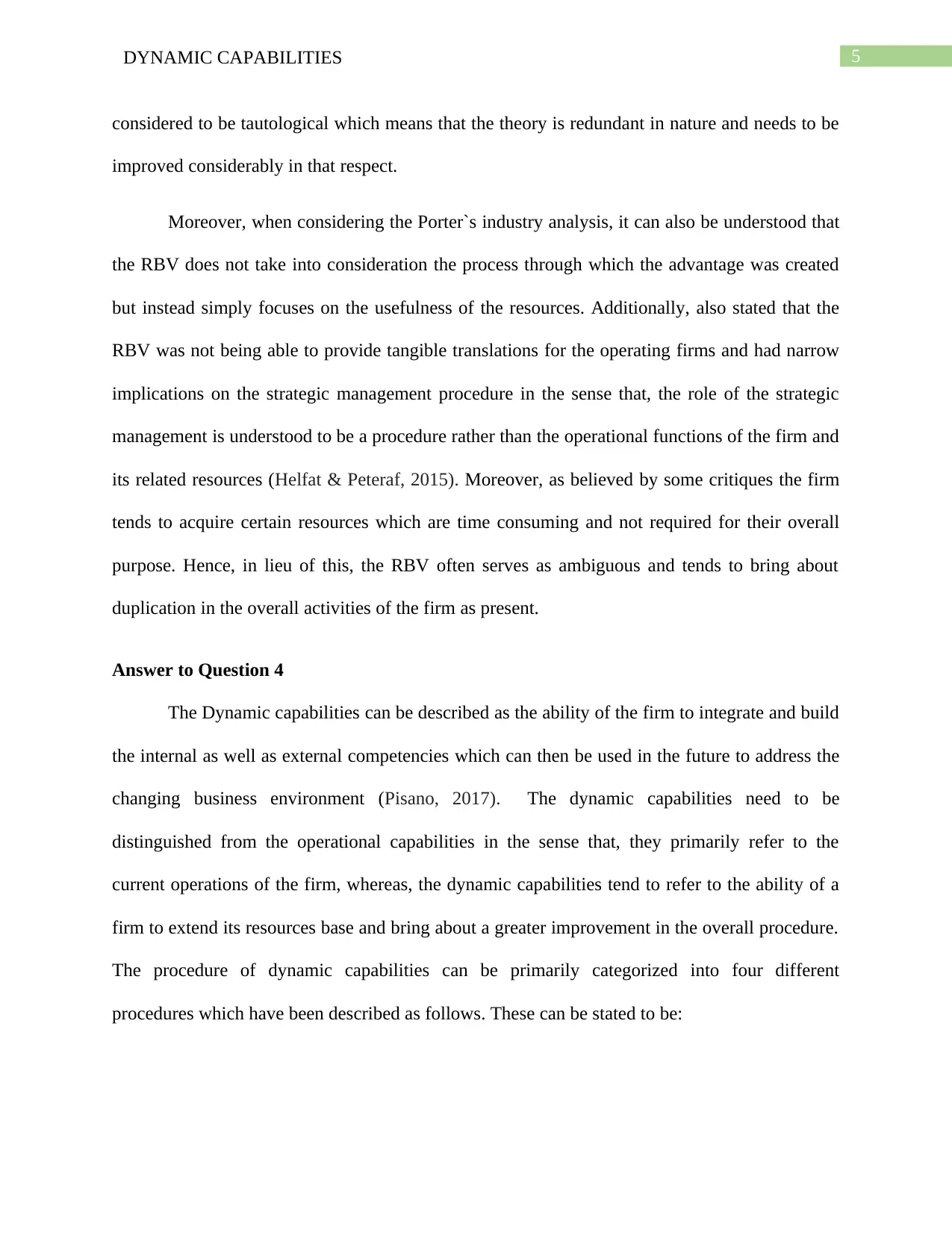
5DYNAMIC CAPABILITIES
considered to be tautological which means that the theory is redundant in nature and needs to be
improved considerably in that respect.
Moreover, when considering the Porter`s industry analysis, it can also be understood that
the RBV does not take into consideration the process through which the advantage was created
but instead simply focuses on the usefulness of the resources. Additionally, also stated that the
RBV was not being able to provide tangible translations for the operating firms and had narrow
implications on the strategic management procedure in the sense that, the role of the strategic
management is understood to be a procedure rather than the operational functions of the firm and
its related resources (Helfat & Peteraf, 2015). Moreover, as believed by some critiques the firm
tends to acquire certain resources which are time consuming and not required for their overall
purpose. Hence, in lieu of this, the RBV often serves as ambiguous and tends to bring about
duplication in the overall activities of the firm as present.
Answer to Question 4
The Dynamic capabilities can be described as the ability of the firm to integrate and build
the internal as well as external competencies which can then be used in the future to address the
changing business environment (Pisano, 2017). The dynamic capabilities need to be
distinguished from the operational capabilities in the sense that, they primarily refer to the
current operations of the firm, whereas, the dynamic capabilities tend to refer to the ability of a
firm to extend its resources base and bring about a greater improvement in the overall procedure.
The procedure of dynamic capabilities can be primarily categorized into four different
procedures which have been described as follows. These can be stated to be:
considered to be tautological which means that the theory is redundant in nature and needs to be
improved considerably in that respect.
Moreover, when considering the Porter`s industry analysis, it can also be understood that
the RBV does not take into consideration the process through which the advantage was created
but instead simply focuses on the usefulness of the resources. Additionally, also stated that the
RBV was not being able to provide tangible translations for the operating firms and had narrow
implications on the strategic management procedure in the sense that, the role of the strategic
management is understood to be a procedure rather than the operational functions of the firm and
its related resources (Helfat & Peteraf, 2015). Moreover, as believed by some critiques the firm
tends to acquire certain resources which are time consuming and not required for their overall
purpose. Hence, in lieu of this, the RBV often serves as ambiguous and tends to bring about
duplication in the overall activities of the firm as present.
Answer to Question 4
The Dynamic capabilities can be described as the ability of the firm to integrate and build
the internal as well as external competencies which can then be used in the future to address the
changing business environment (Pisano, 2017). The dynamic capabilities need to be
distinguished from the operational capabilities in the sense that, they primarily refer to the
current operations of the firm, whereas, the dynamic capabilities tend to refer to the ability of a
firm to extend its resources base and bring about a greater improvement in the overall procedure.
The procedure of dynamic capabilities can be primarily categorized into four different
procedures which have been described as follows. These can be stated to be:
⊘ This is a preview!⊘
Do you want full access?
Subscribe today to unlock all pages.

Trusted by 1+ million students worldwide
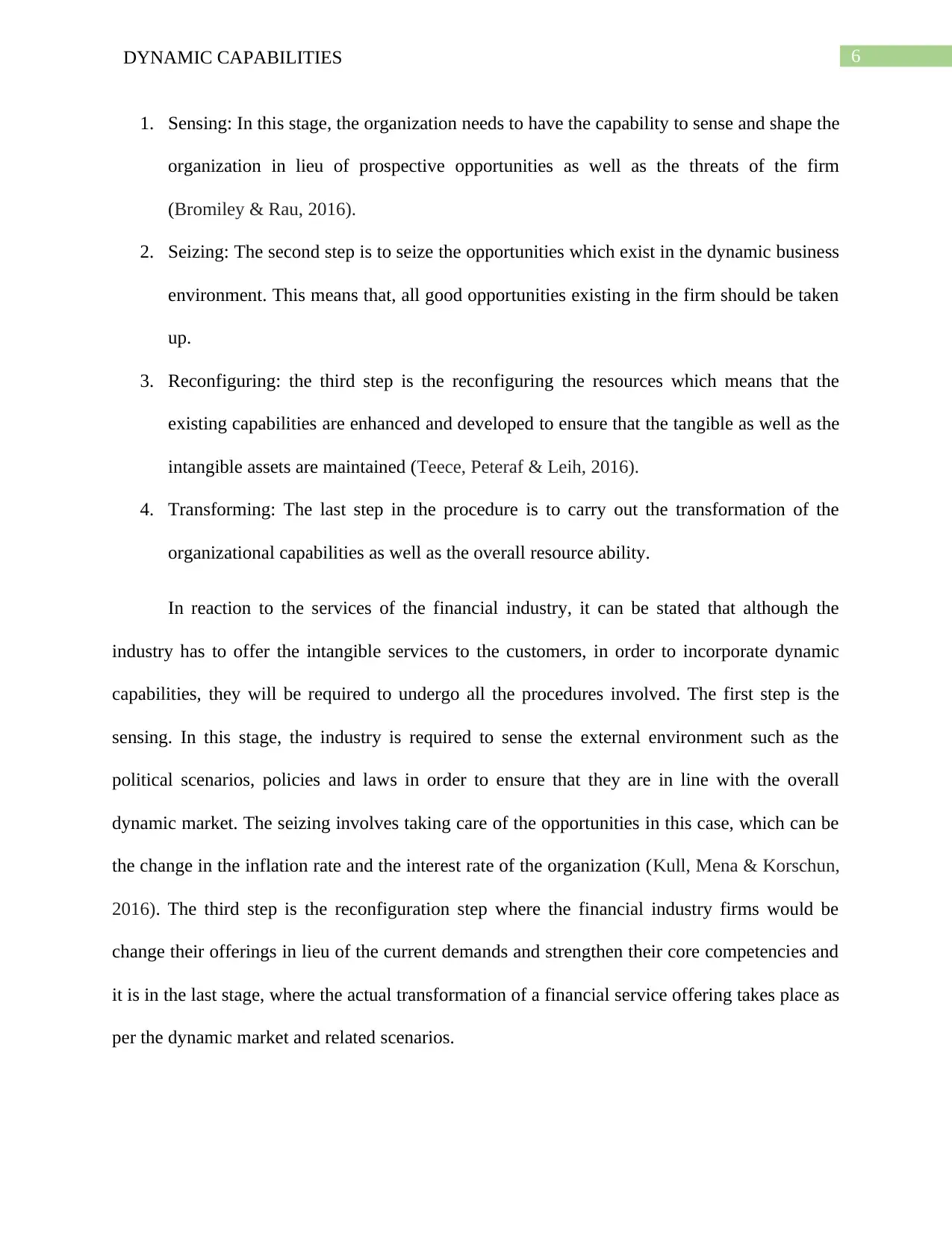
6DYNAMIC CAPABILITIES
1. Sensing: In this stage, the organization needs to have the capability to sense and shape the
organization in lieu of prospective opportunities as well as the threats of the firm
(Bromiley & Rau, 2016).
2. Seizing: The second step is to seize the opportunities which exist in the dynamic business
environment. This means that, all good opportunities existing in the firm should be taken
up.
3. Reconfiguring: the third step is the reconfiguring the resources which means that the
existing capabilities are enhanced and developed to ensure that the tangible as well as the
intangible assets are maintained (Teece, Peteraf & Leih, 2016).
4. Transforming: The last step in the procedure is to carry out the transformation of the
organizational capabilities as well as the overall resource ability.
In reaction to the services of the financial industry, it can be stated that although the
industry has to offer the intangible services to the customers, in order to incorporate dynamic
capabilities, they will be required to undergo all the procedures involved. The first step is the
sensing. In this stage, the industry is required to sense the external environment such as the
political scenarios, policies and laws in order to ensure that they are in line with the overall
dynamic market. The seizing involves taking care of the opportunities in this case, which can be
the change in the inflation rate and the interest rate of the organization (Kull, Mena & Korschun,
2016). The third step is the reconfiguration step where the financial industry firms would be
change their offerings in lieu of the current demands and strengthen their core competencies and
it is in the last stage, where the actual transformation of a financial service offering takes place as
per the dynamic market and related scenarios.
1. Sensing: In this stage, the organization needs to have the capability to sense and shape the
organization in lieu of prospective opportunities as well as the threats of the firm
(Bromiley & Rau, 2016).
2. Seizing: The second step is to seize the opportunities which exist in the dynamic business
environment. This means that, all good opportunities existing in the firm should be taken
up.
3. Reconfiguring: the third step is the reconfiguring the resources which means that the
existing capabilities are enhanced and developed to ensure that the tangible as well as the
intangible assets are maintained (Teece, Peteraf & Leih, 2016).
4. Transforming: The last step in the procedure is to carry out the transformation of the
organizational capabilities as well as the overall resource ability.
In reaction to the services of the financial industry, it can be stated that although the
industry has to offer the intangible services to the customers, in order to incorporate dynamic
capabilities, they will be required to undergo all the procedures involved. The first step is the
sensing. In this stage, the industry is required to sense the external environment such as the
political scenarios, policies and laws in order to ensure that they are in line with the overall
dynamic market. The seizing involves taking care of the opportunities in this case, which can be
the change in the inflation rate and the interest rate of the organization (Kull, Mena & Korschun,
2016). The third step is the reconfiguration step where the financial industry firms would be
change their offerings in lieu of the current demands and strengthen their core competencies and
it is in the last stage, where the actual transformation of a financial service offering takes place as
per the dynamic market and related scenarios.
Paraphrase This Document
Need a fresh take? Get an instant paraphrase of this document with our AI Paraphraser
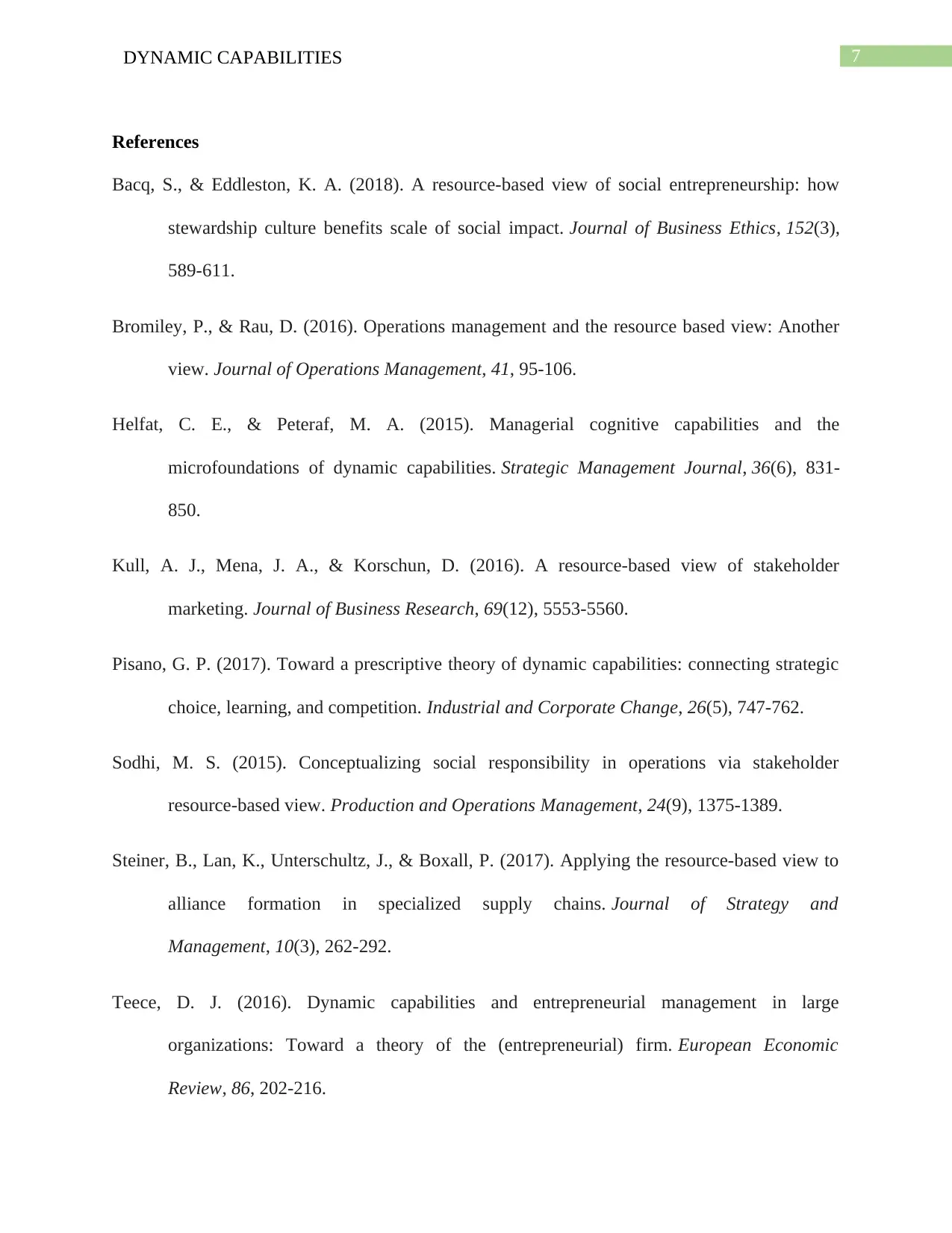
7DYNAMIC CAPABILITIES
References
Bacq, S., & Eddleston, K. A. (2018). A resource-based view of social entrepreneurship: how
stewardship culture benefits scale of social impact. Journal of Business Ethics, 152(3),
589-611.
Bromiley, P., & Rau, D. (2016). Operations management and the resource based view: Another
view. Journal of Operations Management, 41, 95-106.
Helfat, C. E., & Peteraf, M. A. (2015). Managerial cognitive capabilities and the
microfoundations of dynamic capabilities. Strategic Management Journal, 36(6), 831-
850.
Kull, A. J., Mena, J. A., & Korschun, D. (2016). A resource-based view of stakeholder
marketing. Journal of Business Research, 69(12), 5553-5560.
Pisano, G. P. (2017). Toward a prescriptive theory of dynamic capabilities: connecting strategic
choice, learning, and competition. Industrial and Corporate Change, 26(5), 747-762.
Sodhi, M. S. (2015). Conceptualizing social responsibility in operations via stakeholder
resource‐based view. Production and Operations Management, 24(9), 1375-1389.
Steiner, B., Lan, K., Unterschultz, J., & Boxall, P. (2017). Applying the resource-based view to
alliance formation in specialized supply chains. Journal of Strategy and
Management, 10(3), 262-292.
Teece, D. J. (2016). Dynamic capabilities and entrepreneurial management in large
organizations: Toward a theory of the (entrepreneurial) firm. European Economic
Review, 86, 202-216.
References
Bacq, S., & Eddleston, K. A. (2018). A resource-based view of social entrepreneurship: how
stewardship culture benefits scale of social impact. Journal of Business Ethics, 152(3),
589-611.
Bromiley, P., & Rau, D. (2016). Operations management and the resource based view: Another
view. Journal of Operations Management, 41, 95-106.
Helfat, C. E., & Peteraf, M. A. (2015). Managerial cognitive capabilities and the
microfoundations of dynamic capabilities. Strategic Management Journal, 36(6), 831-
850.
Kull, A. J., Mena, J. A., & Korschun, D. (2016). A resource-based view of stakeholder
marketing. Journal of Business Research, 69(12), 5553-5560.
Pisano, G. P. (2017). Toward a prescriptive theory of dynamic capabilities: connecting strategic
choice, learning, and competition. Industrial and Corporate Change, 26(5), 747-762.
Sodhi, M. S. (2015). Conceptualizing social responsibility in operations via stakeholder
resource‐based view. Production and Operations Management, 24(9), 1375-1389.
Steiner, B., Lan, K., Unterschultz, J., & Boxall, P. (2017). Applying the resource-based view to
alliance formation in specialized supply chains. Journal of Strategy and
Management, 10(3), 262-292.
Teece, D. J. (2016). Dynamic capabilities and entrepreneurial management in large
organizations: Toward a theory of the (entrepreneurial) firm. European Economic
Review, 86, 202-216.
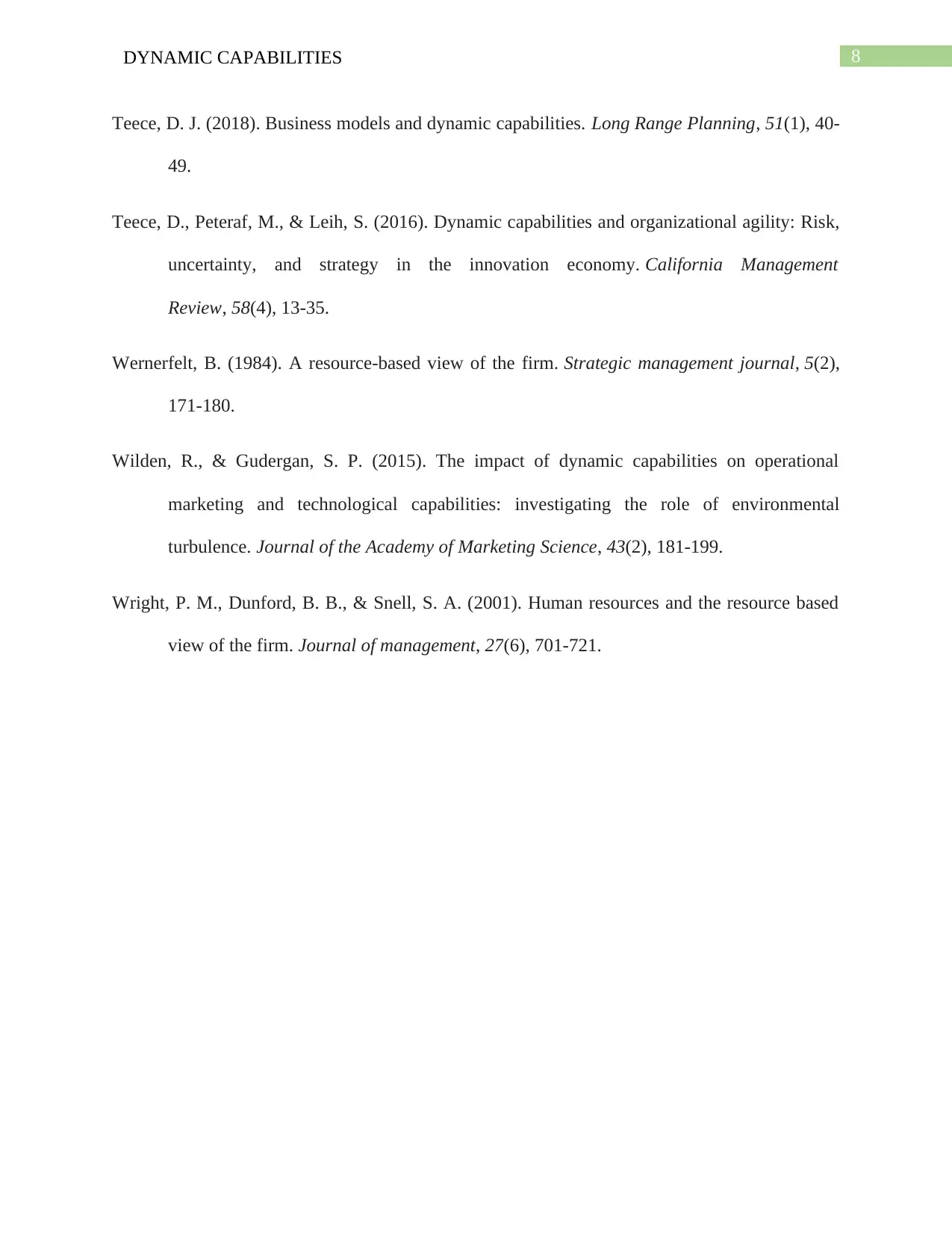
8DYNAMIC CAPABILITIES
Teece, D. J. (2018). Business models and dynamic capabilities. Long Range Planning, 51(1), 40-
49.
Teece, D., Peteraf, M., & Leih, S. (2016). Dynamic capabilities and organizational agility: Risk,
uncertainty, and strategy in the innovation economy. California Management
Review, 58(4), 13-35.
Wernerfelt, B. (1984). A resource‐based view of the firm. Strategic management journal, 5(2),
171-180.
Wilden, R., & Gudergan, S. P. (2015). The impact of dynamic capabilities on operational
marketing and technological capabilities: investigating the role of environmental
turbulence. Journal of the Academy of Marketing Science, 43(2), 181-199.
Wright, P. M., Dunford, B. B., & Snell, S. A. (2001). Human resources and the resource based
view of the firm. Journal of management, 27(6), 701-721.
Teece, D. J. (2018). Business models and dynamic capabilities. Long Range Planning, 51(1), 40-
49.
Teece, D., Peteraf, M., & Leih, S. (2016). Dynamic capabilities and organizational agility: Risk,
uncertainty, and strategy in the innovation economy. California Management
Review, 58(4), 13-35.
Wernerfelt, B. (1984). A resource‐based view of the firm. Strategic management journal, 5(2),
171-180.
Wilden, R., & Gudergan, S. P. (2015). The impact of dynamic capabilities on operational
marketing and technological capabilities: investigating the role of environmental
turbulence. Journal of the Academy of Marketing Science, 43(2), 181-199.
Wright, P. M., Dunford, B. B., & Snell, S. A. (2001). Human resources and the resource based
view of the firm. Journal of management, 27(6), 701-721.
⊘ This is a preview!⊘
Do you want full access?
Subscribe today to unlock all pages.

Trusted by 1+ million students worldwide
1 out of 9
Related Documents
Your All-in-One AI-Powered Toolkit for Academic Success.
+13062052269
info@desklib.com
Available 24*7 on WhatsApp / Email
![[object Object]](/_next/static/media/star-bottom.7253800d.svg)
Unlock your academic potential
Copyright © 2020–2025 A2Z Services. All Rights Reserved. Developed and managed by ZUCOL.





